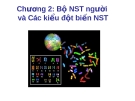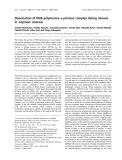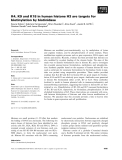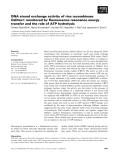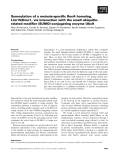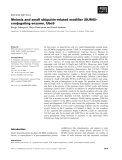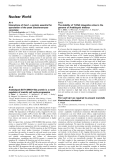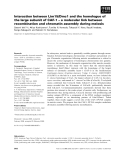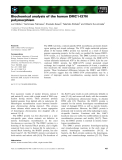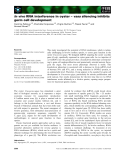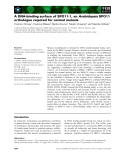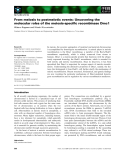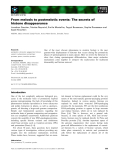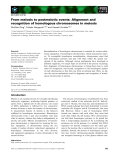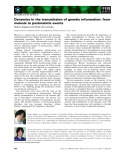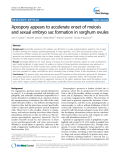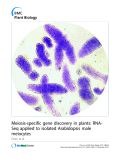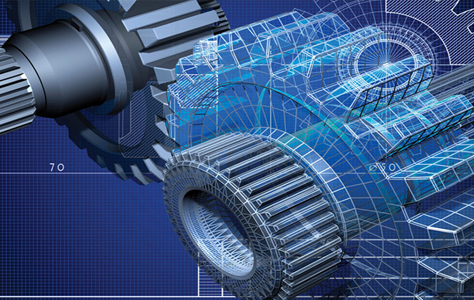
Meiosis
-
Spermatogenesis is a complex process involving mitotic cell division, meiosis, and spermiogenesis. This study aimed to examine the therapeutic effects and mechanisms of Panax ginseng in improving spermatogenesis, using a systematic network pharmacology approach and molecular docking.
 14p
14p  viharuno
viharuno
 03-01-2025
03-01-2025
 8
8
 2
2
 Download
Download
-
Bài giảng Chương 2: Bộ NST người và các kiểu đột biến NST trình bày về SS hữu tính và ổn định bộ NST; hình thái học NST eukaryote; tâm động và các kiểu NST; telomere; các kiểu băng NST; chu kỳ tế bào (cell cycle); giảm phân (meiosis); sự phát sinh giao tử;...Mời bạn đọc cùng tham khảo.
 17p
17p  conchimnon32
conchimnon32
 26-06-2014
26-06-2014
 156
156
 10
10
 Download
Download
-
The primary purpose of the present study was to investi-gate whether DNA replication at meiotic prophase also requires replication factors, especially proliferating cell nuclear antigen (PCNA). We cloned PCNA cDNAs (CoPCNA) from a cDNA library made from basidia of the basidiomycete,Coprinus cinereus. Interestingly, although CoPCNAis a single-copy gene in the genome, two dier-entPCNAcDNA species were isolated using degenerate primers and a meiotic cDNA library, and were designated asCoPCNA-aandCoPCNA-b. ...
 11p
11p  research12
research12
 29-04-2013
29-04-2013
 47
47
 4
4
 Download
Download
-
Previously, the activity of DNA polymeraseawas found in the meiotic prophase I including non-S phase stages, in the basidiomycetes,Coprinus cinereus. To study DNA poly-merasea during meiosis, we cloned cDNAs for the C. cinereusDNApolymeraseacatalytic subunit (p140) and C. cinereusprimase small subunit (p48). Northern analysis indicated that both p140 and p48 are expressed not only at S phase but also during the leptotene/zygotene stages of meiotic prophase I.
 10p
10p  fptmusic
fptmusic
 16-04-2013
16-04-2013
 31
31
 3
3
 Download
Download
-
Histones are modified post-translationally, e.g. by methylation of lysine and arginine residues, and by phosphorylation of serine residues. These modifications regulate processes such as gene expression, DNA repair, and mitosis and meiosis. Recently, evidence has been provided that histones are also modified by covalent binding of the vitamin biotin.
 11p
11p  fptmusic
fptmusic
 11-04-2013
11-04-2013
 40
40
 2
2
 Download
Download
-
Rad51 and disrupted meiotic cDNA1 (Dmc1) are the two eukaryotic DNA recombinases that participate in homology search and strand exchange reactions during homologous recombination mediated DNA repair. Rad51 expresses in both mitotic and meiotic tissues whereas Dmc1 is confined to meiosis.
 10p
10p  inspiron33
inspiron33
 26-03-2013
26-03-2013
 55
55
 5
5
 Download
Download
-
Sumoylation is a post-translational modification system that covalently attaches the small ubiquitin-related modifier (SUMO) to target proteins. Ubc9 is required as the E2-type enzyme for SUMO-1 conjugation to tar-gets. Here, we show that Ubc9 interacts with the meiosis-specific RecA homolog, Lim15⁄Dmc1 in the basidiomyceteCoprinus cinereus(CcLim15), and mediates sumoylation of CcLim15 during meiosis.
 10p
10p  inspiron33
inspiron33
 25-03-2013
25-03-2013
 39
39
 5
5
 Download
Download
-
In this review, we describe the role of a small ubiquitin-like protein modi-fier (SUMO)-conjugating protein, Ubc9, in synaptonemal complex forma-tion during meiosis in a basidiomycete, Coprinus cinereus. Because its meiotic cell cycle is long and naturally synchronous, it is suitable for molecular biological, biochemical and genetic studies of meiotic prophase events.
 13p
13p  galaxyss3
galaxyss3
 19-03-2013
19-03-2013
 28
28
 2
2
 Download
Download
-
The Saccharomyces cerevisiae gene CSM1(SPO86, YCR086w) encodes a protein involved in sporulation - a process equivalent to gametogenesis in higher organisms. Sporulation is part of the yeast life cycle, tightly coupled to such processes as mitosis and meiosis, cell cycle control, genome stability, nutritional control, cell wall morphogenesis, or and intracellular transport.
 26p
26p  galaxyss3
galaxyss3
 19-03-2013
19-03-2013
 42
42
 5
5
 Download
Download
-
In eukaryotes, meiosis leads to genetically variable gametes through recom-bination between homologous chromosomes of maternal and paternal ori-gin. Chromatin organization following meiotic recombination is critical to ensure the correct segregation of homologous chromosomes into gametes. However, the mechanism of chromatin organization after meiotic recombi-nation is unknown.
 10p
10p  media19
media19
 06-03-2013
06-03-2013
 44
44
 2
2
 Download
Download
-
The DMC1 protein, a meiosis-specific DNA recombinase, promotes homol-ogous pairing and strand exchange. The I37N single nucleotide polymor-phism of the human DMC1 protein was reported as a result of human genome sequencing projects.
 9p
9p  vinaphone15
vinaphone15
 27-02-2013
27-02-2013
 29
29
 2
2
 Download
Download
-
Báo cáo khoa học: In vivo RNA interference in oyster – vasa silencing inhibits germ cell development
This study investigated the potential of RNA interference, which is techni-cally challenging in bivalve mollusc species, to assess gene function in the oysterCrassostrea gigas. We designed dsRNA targeting the oyster vasa-like gene (Oyvlg), specifically expressed in oyster germ cells. In vivoinjection of oyvl-dsRNA into the gonad provokes a knockdown phenotype correspond-ing to germ cell underproliferation and prematurely arrested meiosis throu-gout the organ.
 8p
8p  viettel02
viettel02
 22-02-2013
22-02-2013
 33
33
 2
2
 Download
Download
-
Meiotic recombination is initiated by DNA double-stranded breaks intro-duced by the SPO11 protein. Despite a decade of research, the biochemical functions of SPO11 remain largely unknown, perhaps because of difficulties in studying the functionally active SPO11.
 15p
15p  mobifone23
mobifone23
 21-01-2013
21-01-2013
 48
48
 4
4
 Download
Download
-
In meiosis, the accurate segregation of maternal and paternal chromosomes is accomplished by homologous recombination. A central player in meiotic recombination is the Dmc1 recombinase, a member of the RecA⁄Rad51 recombinase superfamily, which is widely conserved from viruses to humans.
 9p
9p  mobifone23
mobifone23
 18-01-2013
18-01-2013
 37
37
 4
4
 Download
Download
-
One of the most obscure phenomena in modern biology is the near genome-wide displacement of histones that occurs during the postmeiotic phases of spermatogenesis in many species. Here we review the literature to show that, during spermatogenic differentiation, three major molecular mechanisms come together to ‘prepare’ the nucleosomes for facilitated disassembly and histone removal.
 6p
6p  mobifone23
mobifone23
 18-01-2013
18-01-2013
 44
44
 4
4
 Download
Download
-
Sexual reproduction depends on the success of faithful chromosome trans-mission during meiosis to yield viable gametes. Central to meiosis is the process of recombination between paternal and maternal chromosomes, which boosts the genetic diversity of progeny and ensures normal homo-logous chromosome segregation.
 19p
19p  mobifone23
mobifone23
 18-01-2013
18-01-2013
 51
51
 4
4
 Download
Download
-
Recombination of homologous chromosomes is essential for correct reduc-tional segregation of homologous chromosomes, which characterizes meio-sis. To accomplish homologous recombination, chromosomes must find their homologous partners and pair with them within the spatial con-straints of the nucleus.
 6p
6p  mobifone23
mobifone23
 18-01-2013
18-01-2013
 45
45
 4
4
 Download
Download
-
The second minireview describes the importance of meiotic recombination in meiosis, and the current understanding of this process and its control mecha-nisms. Imperfections in meiotic recombination have been linked withde novo germline mutations, abnor-mal gametes, and infertility.
 1p
1p  mobifone23
mobifone23
 18-01-2013
18-01-2013
 55
55
 4
4
 Download
Download
-
Tuyển tập báo cáo các nghiên cứu khoa học quốc tế ngành y học dành cho các bạn tham khảo đề tài: Apospory appears to accelerate onset of meiosis and sexual embryo sac formation in sorghum ovules
 13p
13p  panasonic02
panasonic02
 14-12-2011
14-12-2011
 35
35
 4
4
 Download
Download
-
Tuyển tập báo cáo các nghiên cứu khoa học quốc tế ngành y học dành cho các bạn tham khảo đề tài: Meiosis-specific gene discovery in plants: RNA-Seq applied to isolated Arabidopsis male meiocytes
 14p
14p  panasonic02
panasonic02
 14-12-2011
14-12-2011
 54
54
 5
5
 Download
Download
CHỦ ĐỀ BẠN MUỐN TÌM










